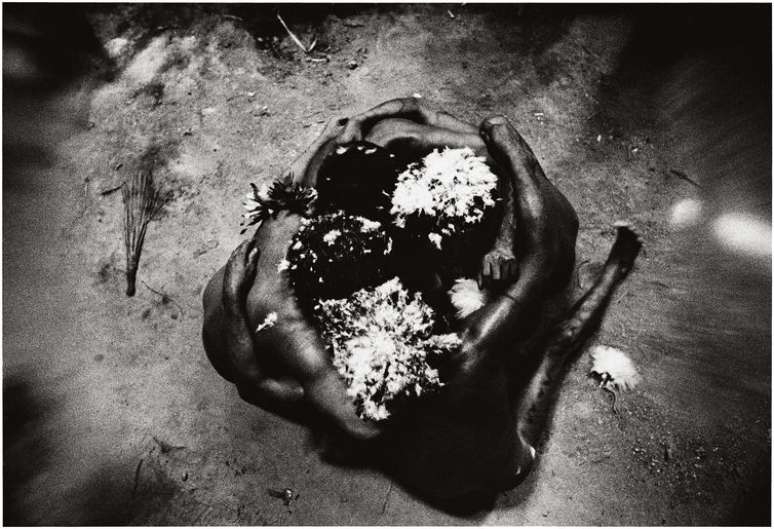The exhibition on display at Itaú Cultural presents the travel diary that Andujar created from inside a beetle
On Wednesday (3), an exhibition on the experiments and journey of the artist and photographer Claudia Andujar began at the Itaú Cultural in São Paulo. The images date back to the photographer’s career in magazine photojournalism Realityincluding the strengthening of photography as an art, as well as the work of recording and denouncing rights violations committed among the indigenous Yanomami.
The curator of the exhibition Claudia Andujar – CosmovisionEder Chiodetto defines the artist as the “legitimate” daughter of the ’68 generation.
“It’s a generation that will change behavior a lot. And obviously all of this has had a huge impact on the field of art. It’s a time when artists are trying to move art again – as happened in surrealism – in this turning point from the ’60s to the ’70s, with pop art, etc. She is the legitimate daughter of that movement.”
The series of photographs on display reveal how Claudia puts photographic language to the test, pushing the limits of traditional photography to provide a more legitimate representation of what she wanted.
The 135 works are divided into 11 series, displayed on two floors of the Itaú Cultural Space. Among her experiments, Claudia used infrared photographic film, scratched chrome, monochromatic filters, rephotographed images with distortions and mutations of light and colors, juxtapositions and double exposures.
Throughout her career, Claudia revisits her collection and works on images according to the intentions of a given moment or project. “You are an artist who will never think of the photograph that comes out of the camera as something ready. Generally speaking, after taking a photograph, you will go through other processing steps until you get where you need to be.”
Right at the beginning of the exhibition, the public will see two series of photographs that present a lesser-known part of his production, working for the magazine Reality. One of these is a series of photographs taken to document homosexuality in the 1960s, which ended up being censored at the time.
“This was for an article published with the title ‘homosexuality’, still considering it a pathology. We are in 1967, under the military dictatorship. And then the report comes out with only the text and the photos are vetoed by the censors”, recalled the curator.
Among the images are two clasped hands, blurred people and the use of shadow where silhouettes are revealed more than identities, as well as a singer performing.
Chiodetto reports that, late last year, these same photographs were exhibited at the ethnographic museum in Budapest, Hungary, which is under the command of a far-right government.
“These photos were in a space there. The Hungarian Minister of Culture ordered to stop the exhibition, put a veto, put everything in a closed room, ban entry to minors under 18 and for this he fired the director of the museum Imagine, almost 60 years later, some of the photos you are seeing [aqui]”, She said.
Even going beyond traditional language, the second series was created at the request of the magazine Reality to represent nightmares. “And it’s wonderful, he photographs his cat, a sculpture he had, a doll. All this here in his apartment. But he will join the images, he will use the shadow, here is a technique that ‘fries’ the negative jelly and this noise is created [na imagem]to arrive at the representation of the nightmare, which is something not visible”, says the curator.
Yanomami
Also in the magazine, he made the first accounts of the Yanomami, in the 1970s, a time in which the ethnic group was subjected to more intense external contacts in the context of development projects during the period of military dictatorship.
“On this trip she has her first contact with the Yanomami, which will completely change her life”, says Chiodetto, adding that the artist “establishes a relationship similar to what happened with the Jews: a hegemonic group attacking a minority group”.
Born in Switzerland in 1931, to a Jewish family, she and her mother fled Nazism to Europe after seeing much of their family taken to concentration camps and murdered.
Claudia became very close to the Yanomami and, in 1976, moved to the village. She goes from Sao Paulo to Roraima in 13 days, traveling in a black Beetle. The exhibition features a series of portraits of indigenous people, with colors representing the green of the forest and the blue of the sky, explains the curator.
Another series of photographs, in another point of the exhibition, illustrates the suffering of the Yanomami in the face of invasions of their territory: “Malencontro gives the name to this series, after the contact between the indigenous people and the whites, the mining invasion, the tragedy that continues today. Then, he goes back to his archive images and, once again, rephotographs to create an atmosphere, a tension about how terrible this ‘discontent’ was for the indigenous people.”
The images correspond to photographs recorded in the 1970s and subjected to processing techniques for an exhibition held at the São Paulo Art Museum (Masp), in 1989, entitled Yanomami genocide: death of Brazil.
“It was already a blunt poster. She takes the images, lights them with a candle and a lamp and photographs them. Having this golden tone, which is the tone of gold, of the white man’s search for gold mining and throwing mercury into the water, leading to the death of many natives.”
New job
At 92 years old, Claudia Andujar reinterprets one of her series, in collaboration with Eder Chiodetto, specifically for this exhibition. During the journey that she took aboard her black Beetle, together with the missionary Carlo Zacquini, to meet the Yanomami, she kept a travel diary using photographs, without leaving the car. “She takes photographs and always has the window of the Beetle, the rear one, the sides, the front one, as if it were another viewfinder. It’s a black and white series.”
In some works in the past, Andujar has superimposed colored acrylics onto photographs. And that’s what they did, this time, in the series of images of their trip. “I took the expanded photographic series [até ela]. To simulate acrylic I took a bunch of cellophane colored with the colors she used and there she said ‘let’s try it here’, I immediately cut it with scissors and in the end it happened. She made ten new pieces,” the curator said.
The name of the series is Watupari’s flight (featured image), which refers to his arrival in indigenous territory. “When she arrives at the village with the Beetle, the natives surround her, because, first of all, they almost never saw a car, it was a very rare thing. And they start laughing a lot and say ‘but, Claudia, you came here on board a vulture, of a watupari?'” he reported. Watupari is what the Yanomami call the vulture.
Main work
The dreams of the Yanomami, the artist’s most important series, according to Chiodetto, materializes in images the universe of the spirituality of those indigenous people based on the artist’s experiments. In one of their rituals, the natives enter a trance, see mirages and then recount the visions they have had. “Claudia was enchanted by the images they described verbally and was incredulous that she couldn’t translate them into an image. She was her frustration.”
Decades later, in 2002, revisiting his collection once again, he accidentally overlaid images recorded in chrome. “And then he starts doing it on purpose, and then there is an ecstasy, a catharsis, that will generate this series here called Sonhos Yanomami. Before he shows it to anyone, he sends it to the village and asks if it has any connection with these images that describe when they come back from trance. And they were crazy about how she did it,” Chiodetto said.
“It is her most important series: when she managed to materialize it, merging the bodies of the indigenous people, with the landscape, with the sky, with the river, with the trees, with the rocks. Because it is largely the belief of the Yanomami, that the rock, the femur and other substances are made of the same atom and all this is a cosmic energy and manages to synthesize this series of Dreams,” he said.
The exhibition will last until June 30, at Itaú Cultural, located at Avenida Paulista, 149. The visit takes place from Tuesday to Saturday, from 11:00 to 20:00; Sundays and holidays, from 11am to 7pm, with free entry.
Claudia Andujar – vision of the world
Itaú Culturale (Avenida Paulista, 149)
From 3 April to 30 June 2024
Tue/Sat 11am/8pm and Sun 11am/7pm
Source: Terra
Ben Stock is a lifestyle journalist and author at Gossipify. He writes about topics such as health, wellness, travel, food and home decor. He provides practical advice and inspiration to improve well-being, keeps readers up to date with latest lifestyle news and trends, known for his engaging writing style, in-depth analysis and unique perspectives.








